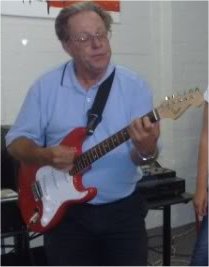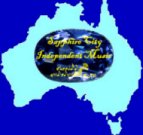I cannot really say when
I began to
write my own music, but it was certainly at an early age. For as long
as I can remember, I had access to my Grandmother’s pianola that had
pride of place in the lounge room of my grandparents’ home. When I was
there, I was allowed to go and play that piano and, while I did not
realise it at the time, I actually did some early composing. In 2002
while packing up to move from Armidale, I found an old music score
booklet that had dates of 1959 and 1960 written in it and the scrawled
music notes (good for a child who could not read music) were certainly
original. My Grandmother often commented (as I recall), on days I had
been playing on the piano for a while, about having been writing new
songs but I always dismissed it by telling her that I was just playing
music. She obviously knew some things that I did not know at the time.
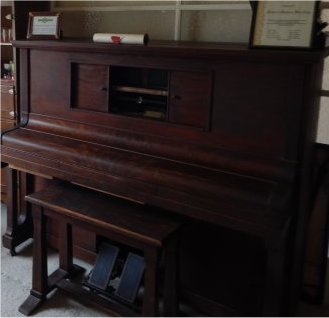
The piano where it all began (I now own this pano)
That
would hardly be surprising because she had an opera singing background
and, while never making it in that field, her voice was always a
delight to listen to, something I had regular opportunities to do in
church during my childhood years. My Grandmother (and I have to define
that I am talking of my paternal Grandmother) was not the only
grandparent with music. Her husband, my paternal Grandfather, was also
a good singer and, sometimes when we were down the paddock in those
childhood years, he would sing and encourage me to sing with him. On my
mother’s side, both grandparents were also musical. Primarily, they
were organists and, certainly during the 50's and 60's, they actually
shared a unique honour of being the only husband and wife (at the time,
at least) to have ever been admitted to the Royal Fellowship of
Organists. Now that is some musical heritage to be blessed with.
My
parents could sing but their avenue of music was in old time dancing,
something that in their latter years, they excelled at, winning many
accolades and honours for what, in the words of one judge, was their
“skill at the movements and their perfect sense of timing”.
As
my siblings and I grew up, we were always surrounded by music and
encouraged in any undertaking we did in the field of music. At one
stage in life, all of us had a turn in the music game.
Apart
from the tinkling of the ivories in those pre-teen days, the other
instrument that I became very keen with was the drums. This really
started when, climbing around the attic of one of the sheds on the
property one day, I discovered an old home made drum kit (bass, snare
and two tom toms, hi hat and a cymbal). These turned out to be a set my
paternal Grandfather had made using ply wood , steel and kangaroo skins
(the pedals, hi hat and cymbal were factory made). At that point in
time, music became a serious part of my life and I was blessed by
having a great teacher in those early days called Max Richards. Max was
a senior boy at our primary school (Boomi Public School) and a very good drummer and he taught me the
drums as part of music at school. Max went on, in the years that
followed, to be part of a quite popular country music band called Men
Of Country. The interest in drums, however, did not stop my love of the
piano.
I went away to boarding school for my secondary education
and my parents did give me the opportunity to take piano lessons, which
I opted to decline. That, as you will see later, is something I never
regretted. However, my secondary schooling did bring me into contact
with some like minded boys and, together, we developed an interest in
singing. It was during this period of my development that I discovered
that I had a natural talent for singing harmonies. My voice range
wasn’t that suited to lead singing but I could do both low and high
harmonies with ease (something the school music teacher could not
comprehend - how I could go both but not be good at the main vocals).
University
opened up more doors and it wasn’t long before three of us guys at the
hostel I stayed in had formed a band with 2 guitars and me on drums. Strangely, I
got the job as lead vocalist as Stephen Yow and Terry Grose were not
really vocalists at all. Terry was a well taught guitar player,
could read music and was a good musical arranger. From Terry, I started
to develop an interest in the guitar and develop an ability to
harmonise instruments as well as the voices part I already
had.
It was also a time when I started to consider the aspect of seriously
writing music. After a time, Terry decided to return to Western
Australia
and a Philippino guy (Manuel Nobleza), also a resident at the hostel, stepped in as a
guitarist. With Terry, we had concentrated on the pop/rock scene but
the change in lineup saw me move to lead guitar as Manuel Nobleza
played bass. Our style changed to a folk/rock. Just three songs survive
on recording from that period - two with Terry and one with Manuel.
This band (with both lineups) was called
The Blue Knights.
During this
time I had also been accepted into the combined Sydney choir for the
annual Easter performance of The Messiah, participation which never
took place as I left Sydney.
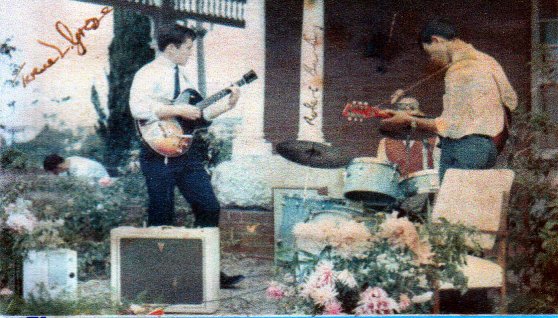
Blue Knghts: L-R - Terry Grose, Bob Burling (drums) Stephen Yow
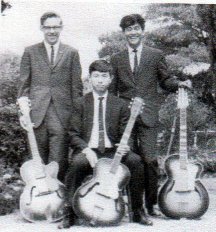
Blue Knights: L-R - Bob Burling. Stephen Yow,
Manuel Nobleza
In 1968 I left university to
follow a career in electronics and that led me to Bingara, in northern
NSW. I hadn’t been there long before I made it my home and met up with
some guys interested in starting a band. The place was good for that as
there was nothing in the town and the teenagers were crying out for a
teen type pop band. The situation was just right.
The first band
was originally called
The
No Names and consisted of Bill Blundell (lead
guitar), Wayne Galvin (rhythm guitar and vocals), Edward Mansfield
(drums) and myself on bass and lead vocals. In the early days my eldest
sister, Betty, also sang vocals. It didn’t take long before we were
travelling the district to other towns to play at school dances and
local clubs. Edward left the band and my bother, Peter, and his mate,
Michael Brown, jointly took over the drumming role. At this point, the
letters of the bands name were reshuffled to become
The Semanons.
During this period of time, several of my own songs were featured in
the band's repertoire, and were always well received.
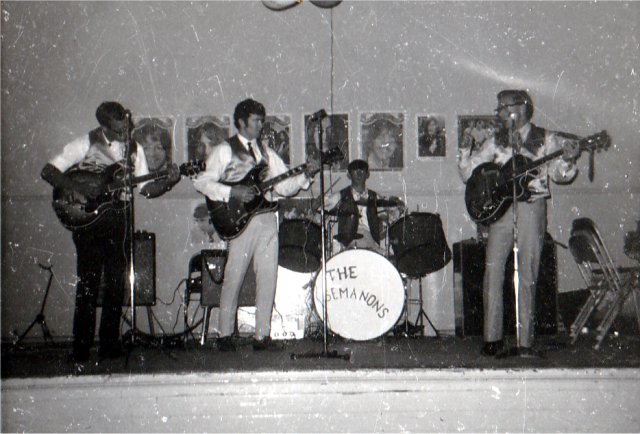
The Semanons line-up. L - R: Bill Blundell, Wayne Galvin, Michael Brown
(drums) and Bob Burling
The band
continued for 18 months, then differences of direction caused the band
to split. I was still more interested in the pop market and took on the
daunting task of teaching, almost from scratch, three guys to play
musical instruments with the idea of filling at least the void for
school dances that now existed. Michael Brown joined the band to learn
bass, Paul Kam to learn rhythm guitar and John Gill on the drums. We
were blessed in getting a basically unused small hall to practice in
and where we could leave our gear instead of having to lug it home. For
the next 6 months it was 3 hours a night, 2 nights a week teaching,
practising and guiding three guys that nobody thought could do it. One
man, however, did have faith in us, Bruce Batterham, the local
newsagent. It just so happened that his business was just behind our
hall and he listened, on many nights, to our progress. He came to
practise one night and told us he was organising a fund raising concert
and he wanted us on the lineup. The other three were not that sure but
I believed they were ready and, obviously, so did Bruce. For the next
month we practiced 4 songs (we needed three for the concert). Stage
jitters were a part of the night, especially for the other 3, but we
made it through, and the band
was now in the
public eye and we got a booking
for the local school from that very night (1971). We were on our way.
The band had started as
Mardi
Gras
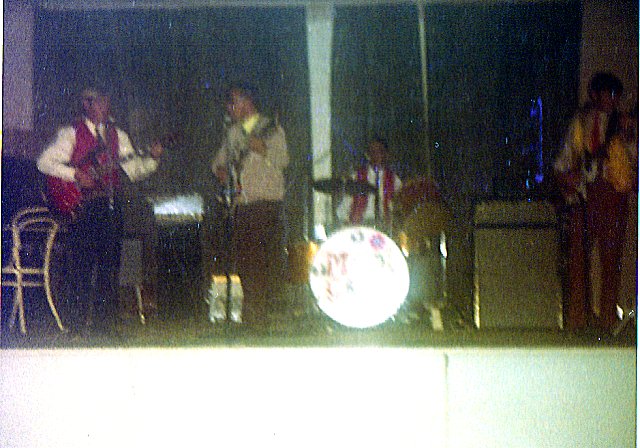
This grainy photo was taken at that first performance of Mardi Gras
L-R, Paul Kam, Bob Burling,
John Gill (drums) and Michael Brown.
After a few months, the band decided to change it's name and by the
time we were in regulat bookings (weekly at least) the band had became
known as
Exodus.
The
next 12 months saw the band grow from strength to strength and bookings
rolled in from a wide area, which was really exciting. During this
period of time my music writing really started to come together though
I was frustrated by the fact that I was still only writing pop songs.
During this period of time we were blessed with a couple of really good
female singers in Robyn Cobcroft and Diane Little. Good voices that
just strengthened the band in many ways. Paul departed the band to join
the army and was replaced by Phillip Pleffer. Phillip actually spent a
month with the band before Paul left and during that period of time we
had a very solid sound.
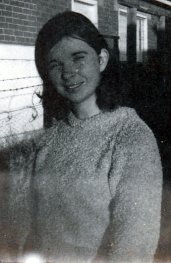
Robyn Cobcroft
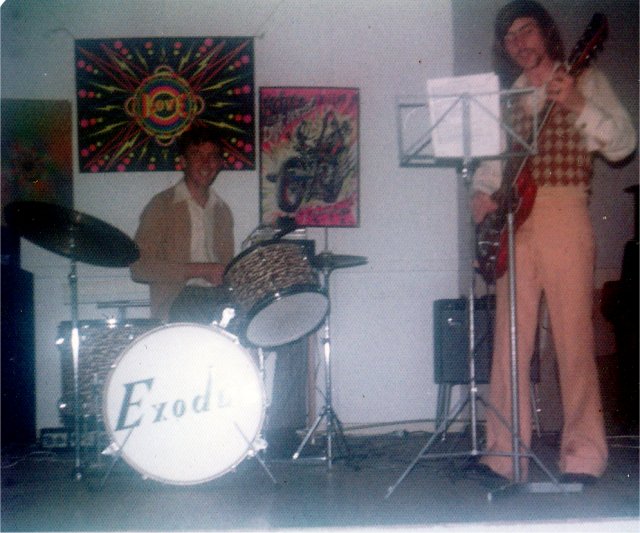
Part of the Exodus Line up: John Gill on drums and Phillip Pleffer
Up until this time, my musical influence
came from a number of sources but most notably from The Hollies, The
Atlantics, Cliff Richard and The Shadows, Elvis Presley and, to a
lesser extent, The Beatles. During this period I started to develop a
desire for a greater depth in my writing and there were a number of
bands
that influenced me over the coming years. Among these were The Moody
Blues, Yes, Pink Floyd, Led Zeppelin, Cream and
Hawkwind.
The first three (along with others) really grabbed my attention with
the idea of concept albums where the whole album was a single theme
and, in some cases, actually had a story. This was a return, in my
mind, to the work of composers such as Tchaikovsky, a long standing
favourite of mine (in fact the very first album I ever purchased was
Swan Lake). I longed to be able to do the same.
It was now
1973 and musicals such as Superstar and Godspell were also around but
they lacked in certain areas. Superstar was a non-Christian
view
of the Gospel story that really missed the mark. Godspell, on the other
hand, was reasonably on target, but was far too short.
I was well
and truly into my music and was really starting to ‘boil’ in my spiritual
development and growth. I was actively involved with the band and was
also experimenting with special youth services to further the youth
work I was actively involved with through the church. The band had really
sharpened my music, both in playing as well as writing music for the
band. There was also a desire in the back of my mind to write something
with substance.
Around the beginning of April,1973 I felt that
something was in the air and, as Easter drew closer, I became aware
that the time was upon me. In the week leading up to Easter I started
to put all external music out of my head. The band practiced two nights
a week but after the Tuesday night practice, we decided not to practice
again that week, as we had no bookings over Easter (the first weekend
in many months). I then decided not to listen to radio or watch TV for
the rest of the week, so that my head was really clear (for someone
like me who listened constantly to music, this was quite an
experience). On the Thursday night I set up the room in my house that I
used as a music room, having brought all my gear back from the hall
where we practiced (we had a room in which to store all our band
equipment).
Good Friday (Friday 20th April, 1973) dawned and I
knew it was on. I even decided not to go to the Good Friday Service. At
10am that morning I entered my music room and the experience that
followed was indescribable. From that time until 2am next morning I
prayed, wrote, arranged and recorded (using a multitrack reel to reel
tape recorder I owned). I had followed Luke’s Gospel (for some reason I
really like Luke and the way he wrote). The last bit of arranging and
recording done, I collapsed into bed. Unsure of what I had done, because
I actually hadn’t listened to any of the finished product.
It
was nearly 11am when I surfaced on Saturday and, after breakfast, went
back into the music room to listen to what I had created. What was on
that tape was roughly 90 minutes of music that really blew my mind. I
couldn’t believe what I had created, but I knew it was very different.
This work was simply called
The
Son
My music had taken a real
turn with this, though I was well aware that I was never likely to be
able to produce this musical in somewhere like Bingara. Two other
musicals followed - one was Christian and much shorter than
The
Son.
This was
That Long Dark
Road. This was followed by a concept album
titled
In Search Of Life,
a duet album that was recorded live to a
private audience with just two people (guitarists and singers) and
explored
the questions about life. All the tracks in this album were long ones
with the 4 tracks lasting 50 minutes. However, the album was not
released until 2012.
Exodus
continued until the economy of the
time dictated that I needed to leave for better work pastures.
Exodus
did its final performance in late 1974 and I moved to Armidale.
I
chose to re-think my music path and explore the ever growing desire I
had for the idea of concept music. However, many things changed. I got
involved with a folk group for about 18 months and at the end of that
period I became involved with a combined churches music group that put
on four Christian musicals, an experience that I really enjoyed.
Having
had a prolific writing time while in Bingara, my song writing became an
almost drought for a number of years. In those early years in Armidale,
I undertook specialist training in audio engineering, something that
was of great help to my music, to sound production in general, and to
the recording and mixing aspect of music. As a result of this
experience, I recorded and released the first
Elhenan
album,
Take What I Am,
as a cassette release. These were songs
that had already been written (mostly written in Bingara). This album was later remixed and
released on CD.
Then came a new
experience in the early 90's. I had moved to a Pentecostal church and
become involved with the church music team. Once again I was writing,
only now it was predominantly Christian music. In the first church I
was involved, we hardly did any of my own material but then I became
involved with a church that had get up and go and I was writing, for a
while, a new song every fortnight (sometimes more than one) and these
were being played all the time at church. This was exciting for me and
really helped me with confidence and presentation.
From there
it was yet another experience. I was invited to lead the music team at
an aboriginal church and that also had exciting experiences and further
allowed me to write. It also taught me about free expression music,
something Aboriginals are really good at. Recorded music in association
with this aspect of my music was done under the name of
Elhenan
and
performances in this area took me to many places.
Elhenan
continues as
my Christian music recording band.
Two gospel albums were recorded in this era but one was not released at
the time.
I
also returned to some mixed performing in the clubs with a disco unit,
where I also did some live performances. I enjoyed the accompaniment of
a couple of very good young female vocalists during that time. The
performances saw the revival of an old name,
Semanon,
under which
I was
now doing all my secular music.
I also got more deeply involved
in my concept writing and the last two albums I wrote and recorded in
Armidale were both concept albums. The first was a
Semanon album called
Rocking
Forward To The
Past and was a nostalgic look at my life story
in music, co-produced by a young woman, Jo Rapley, who did my mixing
for the discos and performances.
The other album was done
under the banner of
InstrumentalOz
and was an instrumental look at the
Book of
Genesis.
In this album I really explored the use of electronic
music and synthetic music, allowing me access to a full range of
instruments to better express the feelings I wanted each track to
convey. This aspect was to lead into something in the coming years.
In
the middle of 2002 I packed up and left Armidale. This move ultimately
turned my world upside down but that also turned out for the best for
my music. Thus began what was to be the third chapter of my musical
career. I found myself now living in Inverell.
Because of a
number of things, I threw myself into my music and part of my
performance aspect was a pleasurable thing in taking part in karaoke at
a local club. It wasn’t long before I had gained a reputation and there
was a couple of young ladies with whom I sang duets on a regular basis.
But it was not fulfilling, because I was only doing other people’s
music and not my own.
In contrast, my writing was becoming quite
prolific again. During the latter part of 2002, as things settled down
a bit
from the beginning of the year, I started to look at some serious new
approaches to my music. I needed challenges and new horizons.
One
thing that I did do was to decide not to get too involved in public
performances and to be very selective about what I did. The karaoke was
a fun and relaxing way to go and allowed me to do some experimenting
with other people’s music. But the rest was to be mostly on a Christian
basis, limiting my public performances to special concerts that
were strictly my own music and I limited involvement in church music
teams. The Pentecostal church was very different in Inverell to what I
had been used to in Armidale and while I was able to exert some
influence on the music of teams I played with, it usually upset others
who were not generally ready for the free movement of that type of
music - they preferred to stay with commercial modern gospel rather
than spirit led. Album wise, I finalised a few albums from
Armidale (ones that had been written, recorded, partly mixed but never
completed) and it
was a year of regrouping. One album from
Semanon,
one from
Elhenan (a
co-operative writing with my youngest sister, Marion Ryan) and one, a
new aspect, was an
album of children’s songs (
Maximilion
Mouse), released under the name of
Uncle Bob
(as it
was originally written for my young niece).
Moving in to 2003, I
returned to my grass roots (in a way) and went back to doing some
instrumental work. There had been many women who had influenced my life
in both positive and negative ways. I opted to try and capture
something of each of these people (some who had been very close in my
life and other who had been just good friends), so instrumentally, was
the best way. I took two songs that I had written back when I was in
Bingara as vocal numbers and reworked them as instrumentals. Thus 14
tracks were crafted into an album called
Instrumentally Remembered
and
released under the name I had used for the
Genesis
album
(
InstrumentalOz).
Then came what was to be a major point in my
life. Little did I realise what I was about to let myself into early in
2004. I cannot remember when I first had the desire to transform The
Book Of The Revelation into music, but each time I thought seriously
about it, I became frightened at the idea, because I did not want the
curse that the last chapter of the book lays out (that any one who
adds or subtracts from the book would be punished) to apply to me.
However, God kept
putting the thought back into my head until finally I made a start.
As
if that choice wasn’t enough, there was another project on the horizon
as well.
My love for classical music has been there all my life but it was only
ever a “listening thing”. However as the year progressed I kept having
this crazy notion to write a symphony. Now this was a challenge,
because I really had no idea of the actual structure of such a work, so
there was a lot of study into styles, structures and instrumentation.
Finally in September of 2004,
Symphony
For Svetlana was released and
this attracted some attention from overseas, where friends who were
really into classical music took interest (one lady was a cellist in a national
symphony orchestra in Belarus) and that gave me much encouragement.
Being the rule breaker that I am in my music, I had breached the rules
(in a way) by introducing a different instrument into the woodwind
section - a didgeridoo - simply to create an Australian atmosphere in
the last movement.
In 2004 I also re-associated myself with an
Aboriginal church. I had known the pastor of the Tingha Fellowship from
my days in Armidale and had, on a couple of occasions, played guitar
with his band. This move gave me a much deeper understanding of the
culture, their way of doing music and, introduced me to a songwriter.
Pastor Paul had a really great influence on my free style of both
playing
and writing and we actually wrote and sang songs together.
This
association highlighted itself with the release of
Homesick
For Heaven
in September of 2005. The title for the album came from a throwaway
line from Pastor Paul one night. Before the meeting was over, the
entire song had been written. This was a regular experience, as the
preachers in that church were constantly giving me subject material and
I always had my notebook and pen in church. Many of the songs on this
album were written that way. What was good was that the songs were
regularly used in meetings and on outreach trips I took with the church
to other communities.
In 2005 I decided that another
Semanon
album was needed and so quite a lot of my spare time (in between
outreach trips with the church and other things that were happening in
my life, like work) preparing, writing and recording tracks for
Black
Leather And Lace, which was released in October
of that
year.
The
next few years saw an absence of recording because, in addition to
doing writing for what had become a major project (
The Revelation
Suite), I was also getting involved with what
was to
become another
influence in my life.
Towards the end of 2008, I took up on
something that had been much a part of my life from personal experience
and from my role as a youth worker. This was the aspect of dealing with
victims of abuse. We are all acutely aware of child abuse but this,
really, is only the tip of the iceberg and, while probably being the
root of all the other forms of abuse, is the only one that gets high
profile
publicity. Sadly, abuse often ends up in the suicide of the victim.
Through
this, an experience of my own, and a group of online friends from all
around the world, a group was formed whose sole purposes were to
provide encouragement and support for all victims of abuse and to raise
the awareness of the high level of abuse. The sad statistic is that at
least one in every four people has experienced abuse, in some way or
other, much of this being in the workplace and through sources that was
to shock many people. It was also the awakening, for me, to the fact
that so much of what had happened in my life was directly attributed to
the abuse I was subjected to in my high school days.
Thus, at
the beginning of January 2009,
Crying In The Silence was formed,
a
website established and we started creating a list of services and
resources in many countries that were able to help in this fight. This
is where my music came in. By the end of January, 2009, the theme song
for the group had been written and recorded and, in what was a fairly
unique project, the song was turned into a video with the help of
people from all around the world. That
video is to be found on YouTube.
Over the next 15 months a number of songs aimed directly at the fight
against abuse, were written and co-written for the project. These,
along with a few other ‘social issues’ songs were put together on an
album entitled
Socially
Restructured, recorded by
White Arrow,
which
was released in March of 2010. Since that time, several other songs
have been written and there are plans for a second album of social
songs for the future.
After this release, time was turned to
another
Elhenan
album as a lot of material had been written and
recorded and needed to be put together and finished. Thus in October of
2010,
Same River - Fresh
Breeze was released and this album included a
duet with Paul Munro, who had co-written some of the song. This album
also saw a couple of prophetic songs.
All through this, in
addition to
The
Revelation Suite, another musical project had
been
moving nicely along. This was a set of six mini musicals that were tied
together in a single major production released as
From
The Garden To
The City - the journey from the Garden Of Eden
(Genesis)
to the end
time end time home of Heaven in Revelation. Each of the mini musicals
was done on a theme that could allow small groups and churches to do
just that one theme, rather than trying to attack a complete musical of
almost 2 hours in length. This album was completed and released in
February 2012.
That month also saw the completion of another
longstanding project that dealt with the theme of time and was a series
of songs (mostly instrumental) that were ‘time relevant’ - this album
was
Time Is But A Day.
Another album of songs had been recorded
back in the late 90's but, for a number of reasons, had not been
released. These songs were reworked, remixed and released as an
Elhenan
album called
Warriors Of
Zion. The bulk of these songs had been
used as part of praise and worship in various churches in that era.
Then
came another project. This one was not planned but just happened. So
much is written about Good Friday but I suddenly realised there was no
real telling of the entire Resurrection Day story (Easter). Over just a
few months, this entire album was written and recorded and released in
July of 2012. The album was entitled
The Day That Changed The World.
A
lot of emphasis is put upon the death of Jesus and its importance to
Christianity but many people have died for others (many of us actually
know people who have died in things such as war so as to give people
freedom) so I had often asked the question ‘Why was the death of Jesus,
on its own,
any different?’ Then I realised that it wasn’t just His death, but it
was the fact that He came back from the dead. Without the resurrection,
His death was no different. His resurrection was what made the
difference and changed the world.
I then turned all my efforts
into completing the project I had started back in 2004. It was a
mammoth recording session that took place over several months but it
finally came together. Now, eight and a half years later, I had finally
finished this enormous project, travelling through so many changes and
ideas in order to complete the task. Finally,
The Revelation Suite
could be released. Along the way, I have learnt much
about my music; about the techniques (musical and technical) I had to
master; about myself; and about the awesome reality of where mankind is
heading with respect to the end of time. In those years, I have lost
track of how many times I have read through that book, in a variety of
different translations, through a variety of different phases in my own
life and under a wide range of circumstances. The Book Of The
Revelation has so much in it that I doubt that any one person could
ever honestly say that they understood everything in it. However, when
you read it through with an open mind and heart, you will be guaranteed
of learning something new each time. That makes it the book that it is.
The album (all 150 minutes of it) was finally released to the public in
October 2012.
Writing this music was blessed by the fact that I
have never felt bound by the rules of formal music and have been able
to "break many traditional music rules" in order to achieve what I have
done. I believe that music should be a true expression of what is
within you and the "rules" that surround music, while being helpful,
can be very restrictive when you desire true expression. I believe that
this work has ultimately allowed me to fully and freely express myself.
As God gave me each piece of music over those years (keeping in mind
that for every part contained in this work, there were 4 other pieces
of music that I wrote) each time was an experience that left a mark on
me as I felt the awesome power that is God and as I gained a gradual
insight into how John must have felt at this experience. I know that I
have certainly felt insignificant and yet empowered as I worked through
this work.
It
was finally, through this writing, that I came to the full realisation
of just how blessed I was to have never had any formal music training.
Sure, I had had many teachers who had shown me many techniques and
skills through those years (and I still love to watch and listen to
other performers to see what I can learn from them) but there was never
any formal music. That has meant that I am not bound by the rules that
come with formal music and allow myself to express the feeling of the
message of the music, regardless of what rules I may appear to have
broken. This also applied to combinations of instruments that I used in
some arrangements and writing.
Writing has continued since the release of this album
though with much less pressure and will, and no doubt will
continue for many
years to come.
As 2013 dawned, I commenced the full scale production of
The
Son
and I have an intention of making sure that
every piece of music I have ever written is finally recorded properly.
This album was finally completed and released early in 2014.
During 2014 a number of other projects were completed. The first of
these was the
W.H.I.T.E.album
(
Worship
Him
In
Tranquil
Exhiliration),
an
album of meditational music with some quite extensive tracks. The
writing of these had been done over many years and recorded as written,
but never released.
Then there was the production of the second Antholgy album (
Anthology
2)
as I recorded much of that early music I had written into an acceptable
quality (two more, at least, such albums are envisaged). This was
released in September of 2014.
Meanwhile,
work had been progressing on another project. Over a number of years a
series of praise songs for children were being written, as I really
believe this is a very neglected area in the modern church. Finally
there was enough material and the recording of
Junior
Praise
was completed for release on the 1st November, 2014. There were 15
tracks on this album that had simple structure (often a single verse
that is repeated) so as to make them easy for children (especially the
younger ones) to learn and present.
The next release was the Elhenan album,
Storm
Calmer, released on the 1st
of December, 2014. This album is more rock oriented than previous
Elhenan
albums, with several tracks making it to the heavy
rock classification. This album also reflects the approaching end time
and many of the songs contain this theme.
In the ensuing years I have concentrated, as health has permitted, on
studio productiion of my material. This has continued and a nunber
of projects are in process at the moment (there is
plenty of material in the archives) though release dates are not yet
determeined. Albums proposed, at this time include 2 more
anthology albums from the early years of my writing (for
Semanon), at least 1 album for
Elhenan, at least one early musical (
That Long Dark Road), as well as others yet to be determined.
